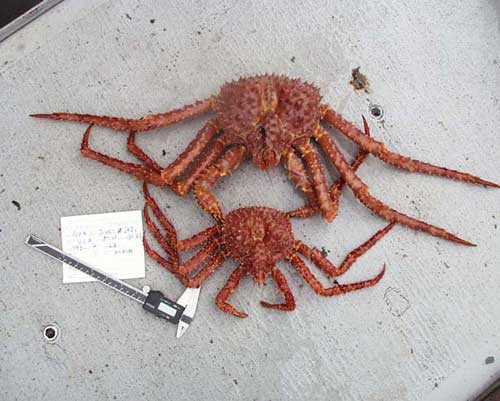 By Laine Welch April 03, 2006
In Japan, for example, researchers ten years ago produced half a million king crab larvae in large hatchery vats. The small crabs were eventually placed in bags in the ocean to harden and after several months, they were released into the ocean. But no follow up was done, so nothing is known about their survival.  Photo courtesy National Marine Fisheries
Gustavo Lovrich of Argentina, who focuses on golden king crab, has discovered that good aeration and water quality are keys to their survival. Likewise, Dr. Kurt Paschke of Chile has learned that tiny golden king crabs grow best when they are raised in the dark, because they spend less energy swimming. Paschke raises his crabs in salmon egg trays using upwelling water, with densities of up to 800 crabs per tray. He has found that with good water exchange, fast growers may reach 100 millimeters in 3.5 years. Paschke hopes to soon produce over 19,000 golden crabs per year. Closer to home, Dr. Tom Shirley at the University of Alaska/Fairbanks School of Fisheries and Ocean Sciences (Juneau campus) has discovered that golden king crabs produce eggs that are 20 times the size of red king crab, and that the newly hatched eggs contain large quantities of lipid (fats). Consequently, they don't need to feed and can live more than six months without doing so. Also in Alaska, Dr. Brad Stevens has raised several hundred red and blue king crab in PVC tubes and beakers over four years at the federal Near Island Research Facility at Kodiak. He said one of his biggest challenges is refining their diet of brine shrimp and diatoms. Stevens credited researcher Gro van der Meeren of Norway with giving the group a "reality check." She pointed out that few crab enhancement programs have been successful due to a lack of ecological understanding. The goal is simple: to release small crabs, and allow them to grow to maturity and recapture them. She told the group that the animals must first be adapted to their new conditions in the wild. They need to be released under correct light and temperature conditions, they need to find shelter immediately, and the habitat must be appropriate. Stevens added: "We need to give hatchery raised crabs the chance to acquire adaptive behaviors by challenging them in the lab with natural habitats, foods and predators. And in order to determine the effectiveness of such a program, we need a method to mark hatchery raised crabs in order to distinguish them from wild crabs." Stevens said it is certainly possible to enhance king crab stocks in Alaska, but it would require a large financial outlay. "I'm guessing $20 million for a facility and operating costs of $2 - $3 million a year. Those are government estimates," he said, adding that the cost would likely be far less if a project was undertaken by fishermen. Stevens said, "If you
started with 200 females, you could expect to produce 30 million
larvae. Survival to the first crab stage might range from 25
to 75 percent, and survival to maturity or capture size about
eight years later might range from three to 25 percent if you're
lucky. At current prices, that should produce a benefit to cost
ratio of from one to ten. If you're a banker and your goal is
to make money, you say this is not the best investment. But if
your goals are to maintain fishing opportunities, to re- establish
depleted populations, to provide employment for fishermen and
their offspring, to maintain the socioeconomic structures of
coastal communities, and to produce a high quality seafood product
, then maybe it would be a good thing." Twenty sweepstakes winners
will each receive 20 pounds of Copper River salmon fillets from
Prime Select Seafoods of Cordova. The grand prize winner will
receive a fishing adventure for four hosted by Cordova's Alaskan
Wilderness Outfitting Company. Last year Alaska Airlines transported
more than 30 million pounds of Alaska seafood to markets in the
U.S., Canada and Mexico. Meanwhile, another study in
Britain has added to earlier claims that omega-3s in fish oils
can help with children's behavioral problems. Seafood.com reports
that a group of 25 youngsters aged 12 to 15 with severe attention
deficit/hyperactivity disorder (ADHD) were given fish oil supplements
for three months. Before the trial began, 94 percent of the subjects
had high ratings for inattention and impulsivity. After taking
the fish oil supplements, the severe impulsivity was cut to 28
percent and severe inattention fell to 17 percent. The lead researcher,
Madeleine Portwood, called the results "stunning."
Portwood conducted a similar study on younger children aged 18
months to 30 months and found omega 3 supplements improved their
behavior. Publish A Letter on SitNews Read Letters/Opinions Submit A Letter to the Editor
|